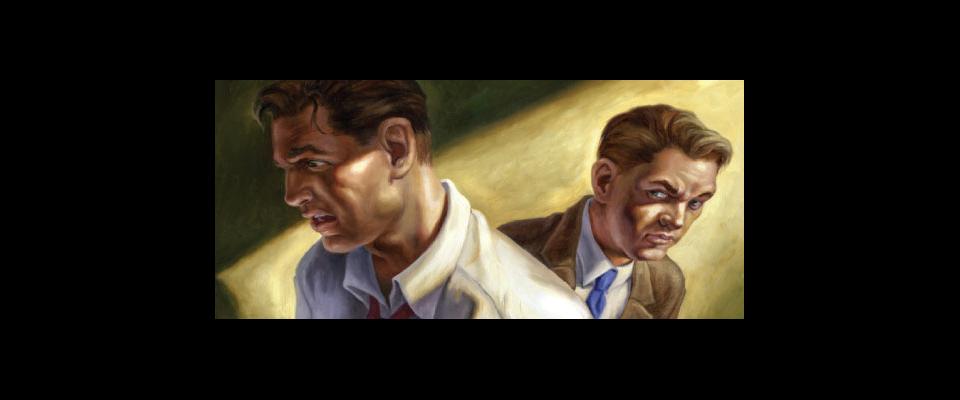Three Berkeley men converged to create the lie detector
The others had filed out, leaving the suspect and the prosecutor alone in the room. Decasto Earl Mayer, suspected of murdering James Bassett, was ready to cop a deal. For eight hours a day, five days straight, Mayer had been strapped to a newfangled machine called a polygraph while its operator, Leonarde Keeler, questioned Mayer about the location of the body. Mayer had refused to answer certain questions and had attacked the instrument. He was restrained, the machine was repaired, and the interrogation continued until, finally, the suspect offered his confession.
“I know what that machine is,” Mayer reportedly told the prosecutor. “I know it’s recording the truth. I can’t beat it. Let’s not kid each other. You know and everybody else knows that I killed Bassett. What will you do for me if I come clean?”
According to the machine, Mayer showed great anxiety when asked if he had shot Bassett; if he’d buried the body; if he’d hidden it near the “Little White House.” For days, Keeler carried out his “fishing expedition,” pointing to places on a map, asking if the body was at each spot, and interpreting Mayer’s reactions on the polygraph chart. Keeler had narrowed it down to two cemeteries in the Bothell area outside Seattle when Mayer finally confessed.
Keeler rushed to send a wire to Chicago: TOP BLEW OFF KETTLE THIS MORNING STOP PLENTY OF EXCITEMENT STOP WE ACTUALLY OBTAINED CONFESSION AND SOON WILL HAVE BODY STOP.
The date was November 18, 1929.
The case of Decasto Earl Mayer is just one of the countless procedural dramas in the story of the machine best known as the “lie detector”—an instrument that, despite almost constant controversy surrounding its validity, has never gone out of use. The story, rooted in the history of Berkeley, is ably told by Ken Alder in his book The Lie Detectors: The History of an American Obsession. It is a story of three men: Berkeley police chief August Vollmer; physiologist John Larson, Ph.D. ’20; and Berkeley-born Leonarde Keeler, who would become the machine’s most conspicuous promoter and the man responsible for the many sleight-of-hand methods that haunt the machine’s legacy to this day.
August Vollmer was a pioneer of modern law enforcement: He was the first police chief to recruit college graduates and to require new hires to take intelligence tests; the first to put cops on bicycles and in squad cars and to install two-way radios; the first to systematically classify fingerprints and use forensic techniques to analyze blood, fibers, and handwriting in detective work. Though Vollmer never finished the sixth grade, he established the country’s first criminology program at the University of California in 1916.
In 1920, 29-year-old John Larson joined the Berkeley police force, having just earned his Ph.D. in physiology from the University. This was another first—a patrolman with a doctorate. Larson, who’d written his thesis on fingerprints as a predictor of deviant tendencies, was an austere and dedicated scientist. When he wasn’t moonlighting on patrol, he was writing a book on fingerprinting, auditing classes in criminal psychiatry, and redesigning a machine invented by Harvard lawyer and psychologist William Moulton Marston. Marston’s was a crude device that intermittently measured blood pressure while a subject spun out a tale. Testing his fellow students at Harvard’s emotion laboratory, Marston found that the feedback could signal when someone was lying.
After reading one of Marston’s articles, Larson saw potential for the device to be used in law enforcement, and soon enlisted help from Berkeley’s physiology department to build a machine that continuously charted blood pressure and breathing. Typical of his scientific mind, Larson called the machine the “cardio-pneumo-psychograph,” but informally he favored “the apparatus.”
With Vollmer’s blessing, Larson used the machine to test every kind of deviance and criminality. Between 1920 and 1923, he strapped 861 subjects to the apparatus, finding over 200 guilty as charged, and absolving more than 300.
In the summer of 1921, the San Francisco Call and Post arranged for Larson to use the apparatus to test William Hightower, accused of murdering a priest in San Francisco. The newspaper reported Larson’s findings the following morning: Hightower was pronounced guilty by impartial science. The graphic results of the interrogation were printed large across the page, with arrows marking each presumed lie. Vollmer exalted the machine to the press, which renamed it the “lie detector.”
It was a name Larson would come to hate as his faith in the machine waned. His new protégé, however, would suffer no such qualms.
Leonarde Keeler, born in 1903, was the son of Charles Keeler, Berkeley’s most famous poet. As a young man with a penchant for getting into trouble, Leonarde was introduced by his father to August Vollmer. The elder Keeler asked the chief if the troublesome Leonarde could see a demonstration of Larson’s apparatus firsthand. Keeler’s son quickly became absorbed with the machine, and Larson took him on as an apprentice.
After high school, Keeler enrolled at Berkeley but neglected his course work in favor of tinkering with Larson’s machine. When his mentor, Vollmer, left Berkeley to head the Los Angeles Police Department in 1923, Keeler followed, transferring to the “southern branch,” now UCLA.
In Los Angeles, Keeler built a new machine, similar to Larson’s Berkeley device but running on alternating current and better able to register pressure from the tubes to the recorder. Vollmer recalled the machine’s looking “like a crazy conglomerate of wires, tubes, and old tomato cans.” Keeler termed his new contraption the “polygraph,” meaning simply meaning “many-writing instrument.”
Larson, meanwhile, moved to Chicago for medical school, taking a job with the Institute for Juvenile Research, where he continued working with his own apparatus.
Thus, the lie detector and its operators migrated to two of the country’s most crime-ridden metropolises, where police still relied on the “third degree” to get convictions. The Chicago cops, Larson wrote, “had apparently never seen a scientific method of any kind, but rely on a billy and a rubber hose with a chain in it to get their confessions.” Part of Larson’s great hope for his instrument was to end the physical abuse of suspects.
The problem was, evidence from lie detector tests was not allowed in courtrooms.
In 1922, William Moulton Marston, inventor of the original machine, was barred from giving expert testimony or submitting “deception test” results in defense of accused murderer James Alphonso Frye, who was ultimately convicted of second-degree murder and sentenced to 15 years behind bars. The defense appealed, and in a famous opinion, D.C. court of appeals Justice Josiah Alexander Van Orsdel wrote, “While courts will go a long way in admitting expert testimony deduced from a well-recognized scientific principle or discovery, the thing from which the deduction is made must be sufficiently established to have gained general acceptance in the particular field in which it belongs.”
Larson, who had contributed his name and research in support of Marston’s efforts in the Frye case, wrote to Keeler that it had been too early to try to get the machine admitted in court. Afterward he cited Marston’s failure as a giant setback for the machine’s gaining scientific legitimacy.
Not mentioned in Van Orsdel’s ruling was another worrisome prospect: If lie detector results were admissible in court, the machine would likely supplant juries as the rational force that determined a person’s guilt or innocence. The judge in the original case had been explicit on that count: Juries, he declared, were better suited to “determine whether or not a man is telling the truth.”
Keeler, on the other hand, saw the jury as unreliable and easily duped. “Someday I can picture a medical legal committee with no judges, no lawyers in particular,” he said in an interview years later, “but instead some scientific experts who will examine suspects and render a decision as to their guilt and opinions of their personality. Such well-trained men can better judge the reactions and social possibilities of a man than a haphazard group of businessmen and lawyers.” Keeler envisioned such a “committee”—polygraph operators included, of course—replacing nearly every aspect of the criminal justice system from the judge on down. Convicts would be “studied continually” to determine whether they needed “medical, psychological, or industrial training”; prisoner releases wouldn’t be decided based on the “whims of parole boards” but on “rigidly qualified” scientists.
Keeler’s grand vision amounted to orthopedics for the soul of the body politic, with Keeler’s polygraph as panacea. In reality, the machine had become little more than a tool for obtaining confessions. In that, at least, it had proven effective.
In Chicago between 1923 and 1927, Larson, while working toward his medical degree, tested the lie detector on more than 200 children at the Institute for Juvenile Research. While some proponents (Vollmer included) were making grandiose claims about the device’s accuracy, Larson found its results inconclusive about 40 percent of the time.
Meanwhile, Keeler had transferred to the psychology department at Stanford University. To pay their way, he and a friend bought and raised some 70 rattlesnakes and ran a “milking” farm, extracting the venom and selling it to a company that made antivenin. Typical of his bravado, Keeler petitioned the Stanford faculty to allow him to try a rattler antidote on himself before allowing one of the snakes to bite him. The proposal was reviewed and flatly denied. Not surprisingly, the newspapers in Palo Alto were enamored with the 20-year-old snake charmer, and story after story extolled his resourcefulness and daring with the rattlers.
But the snakes were nothing compared to Keeler’s real financial coup: marketing the Keeler Polygraph, which he had tried and failed to patent as his own invention. After all, Keeler hadn’t so much invented an original machine as a method for using it in interrogations. Instead of selling the polygraph and glutting the market with machines, Keeler set up as a consultant, and trained operators according to his own examination methods.
For years, Keeler honed his interrogation technique, first at Stanford, then moving to Chicago to work for Northwestern University’s Scientific Criminal Detection Laboratory. One of his trademark methods was the “card trick” test. While rigged to the polygraph, a subject would be instructed to pick one of eight playing cards and then place it back among the others. Keeler would then go through the cards, after instructing the subject to deny having chosen each one, thereby forcing a lie. When the selected card was shown, respiration would typically drop and the heart rate would shoot up. After the subject’s card was drawn, the heart rate and breathing would even out, a sign of relief. Always something of an amateur magician, Keeler often used marked cards to be certain he could call the right one. It was a means to an end: The better the examiner convinced the test subject that the machine could pick out the lies, the more dramatic the results would be.
Today, this technique is known as the “stimulation test” and can be found in a 1997 textbook given to Department of Defense Polygraph Institute examiners. “DO NOT show the test to the examinee,” the book instructs, “but convince the examinee that deception was indicated.” After administering the test, the examiner is to describe the results to the subject: “That was excellent. It is obvious that you know lying is wrong. You’re not capable of lying without your body reacting…. That will make this examination very easy to complete as long as you follow my instructions.”
The key is to cultivate a belief in the machine and its ability to spot lies. During his time in Berkeley, Larson had often noted that many subjects under the influence of the apparatus readily confessed to the crimes they were accused of, but also admitted to an array of other embarrassments. Notably, Larson found that when he questioned subjects after they had confessed, the chart appeared much as it would have for those determined to be innocent.
Larson was more than skeptical of Keeler’s methods. He deplored any use of the machine that wasn’t bound by scientific method. In letters to Vollmer and others over 25 years, Larson skewered Keeler behind his back, questioning his method, his commercial pursuits, and his scientific credentials. He called Keeler’s approach a “racket” and accused him of stealing others’ ideas, saying that Keeler had developed “a psychological third degree.”
It wasn’t just his protégé he renounced; Larson regretted ever inventing the apparatus. Shortly before his death of a heart attack in 1965, Larson wrote, “Beyond my expectation, thru uncontrollable factors, this scientific investigation became for practical purposes a Frankenstein’s monster, which I have spent over 40 years in combating.”
Like Frankenstein’s creation, the polygraph refuses to die. It has found its way into all corners of American life—not just in criminal investigations, but also in civil suits, divorce settlements, military and intelligence agencies, and even pop culture (think F. Lee Bailey’s 1983 TV show Lie Detector).
In 1983, President Reagan moved to expand the use of the polygraph to screen government employees in all federal agencies. In that year, 22,000 government employees were tested on the machine, with most of the exams carried out by the Department of Defense and the National Security Agency. Also in that year, the Congressional Office of Technology Assessment reported that the polygraph rested on shaky theoretical ground and that too many variables could affect outcomes. In 1988, Congress passed the Employee Polygraph Protection Act, prohibiting private employers from using the machine to screen employees; nevertheless, the practice remained common for government posts. Fifteen years later, after the Department of Energy began increasing the screening of employees, the National Academy of Sciences and the National Research Council concluded in a report that “the scientific evidence supporting the accuracy of the polygraph to detect deception is intrinsically susceptible to producing erroneous results.” In short, polygraph testing is an “unacceptable choice.”
In some ways, the case of Decasto Earl Mayer foreshadowed the fate of the polygraph. No sooner had Keeler wired Chicago about the confession than Mayer denied making the statement, and his lawyers accused Keeler and the prosecutor of torture.
In a maelstrom of criticism that followed, the papers printed a photo of Mayer, wan and haggard, next to a picture of Keeler with the polygraph. Readers were titillated with full-page tales of Mayer’s forced drugging with chloroform and the “truth serum,” and long hours of interrogation on the lie detector. They ran photos of officers exhuming graves in search of Bassett’s body. It was revealed that after Mayer had smashed the machine, he was bound with a special shackle called an “Oregon boot,” which tightened around his leg each time he moved. Reportedly, when Mayer refused to look at the maps any longer, deputies forced his eyes open until he convulsed in seizure.
The judge in the case likened Mayer’s treatment to the Spanish Inquisition, and the Wickersham Report called it “one of the outstanding third-degree cases in the United States.”
The polygraph, originally touted as the end of coercion, had become yet another tool for abuse. Mayer was locked away for a string of felonies, the theft of Bassett’s car among them, but was never convicted of the murder. He eventually hung himself in his prison cell. Keeler, though, remained undeterred. The polygraph’s proponents would soon claim that the Mayer case had been a victory for law enforcement, and that the machine had quickly led to the discovery of Bassett’s body.
In truth, the body was never found.






















